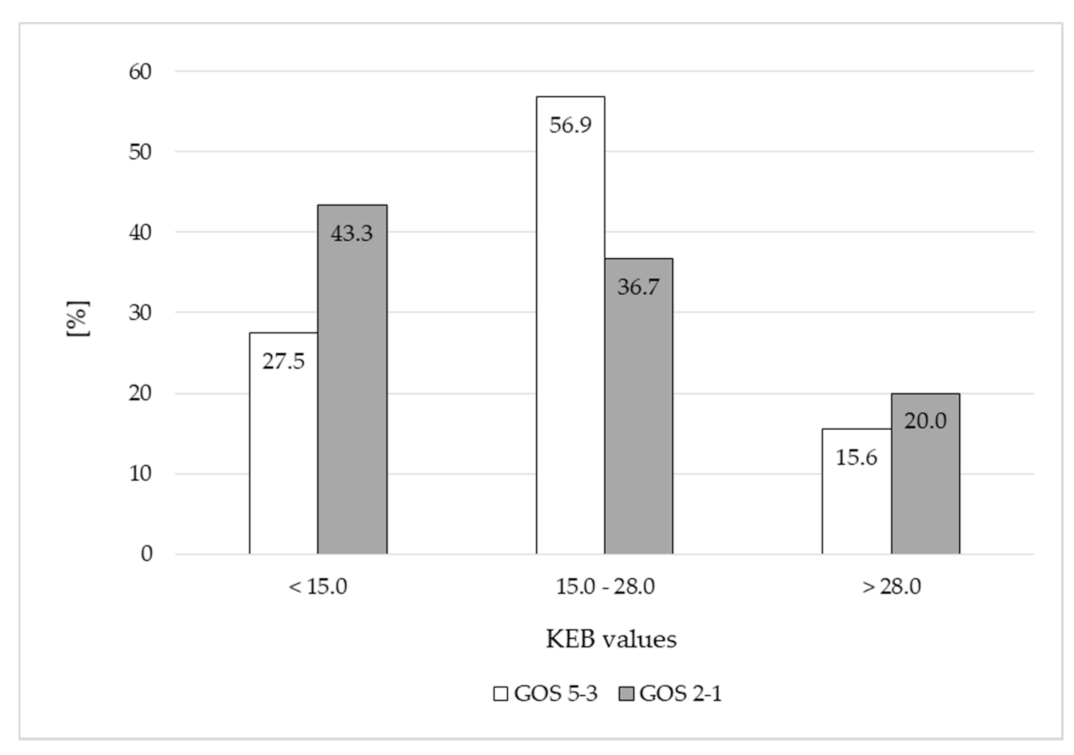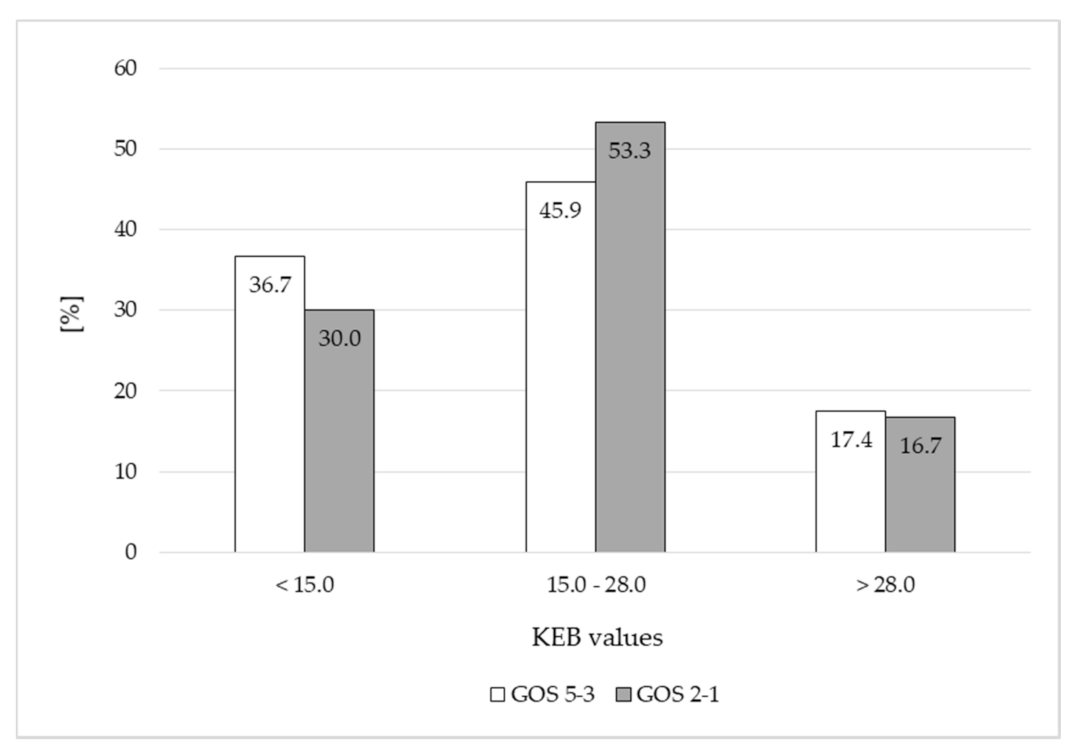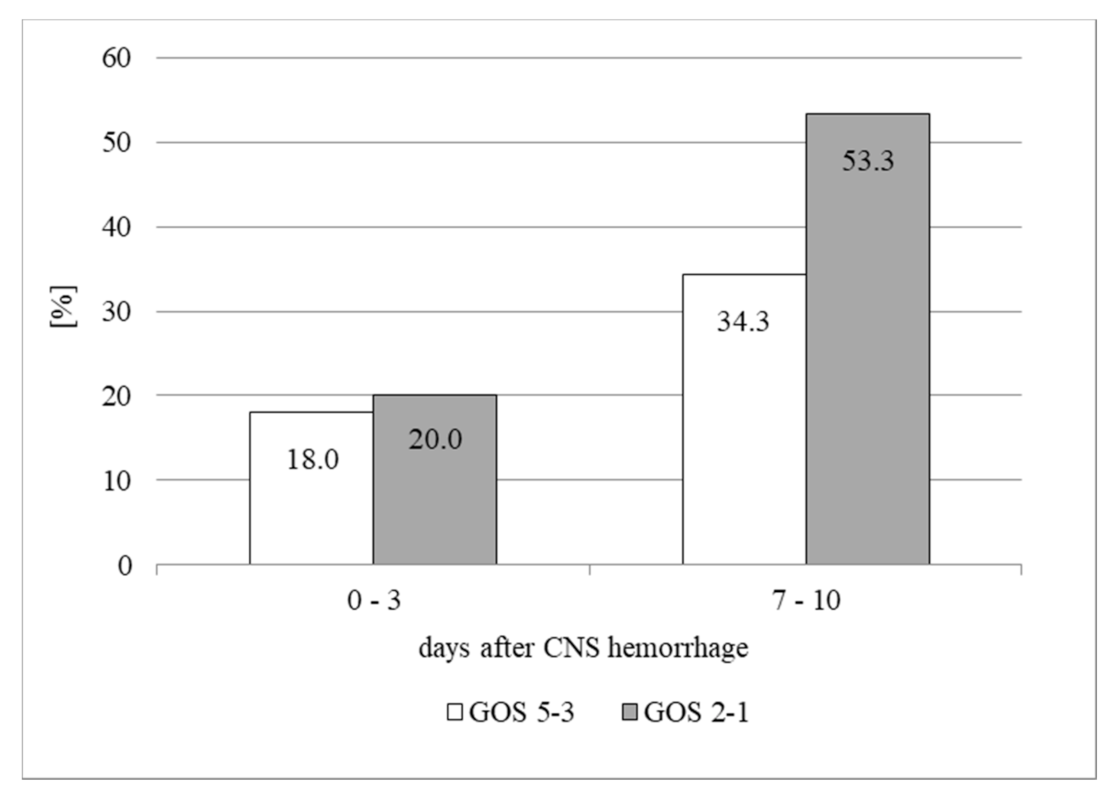Development of the Cerebrospinal Fluid in Early Stage after Hemorrhage in the Central Nervous System
Abstract
1. Introduction
1.1. Cytological Investigation of the CSF
1.2. Investigation of Biochemical Parameters in the CSF
Energy Assessment of Inflammation in the CSF
- [glucose] = molar concentration of glucose in the CSF (mMol·L−1).
- [lactate] = molar concentration of lactate in the CSF (mMol·L−1).
2. Material and Methods
2.1. Patients
2.2. CSF Analysis
2.3. Statistical Analysis
3. Results
4. Discussion
5. Conclusions
Author Contributions
Funding
Institutional Review Board Statement
Informed Consent Statement
Data Availability Statement
Acknowledgments
Conflicts of Interest
References
- Sreekrishnan, A.; Dearborn, J.L.; Greer, D.M.; Shi, F.-D.; Hwang, D.Y.; Leasure, A.C.; Zhou, S.E.; Gilmore, E.J.; Matouk, C.C.; Petersen, N.H.; et al. Intracerebral hemorrhage location and functional outcomes of patients: A systematic literature review and meta-analysis. Neurocrit. Care 2016, 25, 384–391. [Google Scholar] [CrossRef]
- Dumont, A.S.; Dumont, R.J.; Chow, M.M.; Lin, C.; Calisaneller, T.; Ley, K.F.; Kassell, N.F.; Lee, K.S. Cerebral vasospasm after subarachnoid hemorrhage: Putative role of inflammation. Neurosurgery 2003, 53, 123–135. [Google Scholar] [CrossRef] [PubMed]
- Wang, J. Preclinical and clinical research on inflammation after intracerebral hemorrhage. Progress Neurobiol. 2010, 92, 463–477. [Google Scholar] [CrossRef]
- Fassbender, K.; Hodapp, B.; Rossol, S.; Bertsch, T.; Schmeck, J.; Schütt, S.; Fritzinger, M.; Horn, P.; Vajkoczy, P.; Kreisel, S.; et al. Inflammatory cytokines in subarachnoid haemorrhage: Association with abnormal blood flow velocities in basal cerebral arteries. J. Neurol. Neurosurg. Psychiatry 2001, 70, 534–537. [Google Scholar] [CrossRef] [PubMed]
- Sercombe, R.; Dinh, Y.R.T.; Gomis, P. Cerebrovascular inflammation following subarachnoid hemorrhage. Jpn. J. Pharmacol. 2002, 88, 227–249. [Google Scholar] [CrossRef] [PubMed]
- Beer, R.; Pfausler, B.; Schmutzhard, E. Infectious intracranial complications in the neuro-ICU patient population. Curr. Opin. Crit. Care 2010, 16, 117–122. [Google Scholar] [CrossRef] [PubMed]
- Tso, M.K.; Macdonald, R.L. Acute microvascular changes after subarachnoid hemorrhage and transient global cerebral ischemia. Stroke Res. Treat. 2013, 2013, 425281. [Google Scholar] [CrossRef] [PubMed]
- Miller, B.A.; Turan, N.; Chau, M.; Pradilla, G. Inflammation, Vasospasm, and brain injury after subarachnoid hemorrhage. Biomed. Res. Ind. 2014, 2014, 384342. [Google Scholar] [CrossRef]
- Hoogmoed, J.; van de Beek, D.; Coert, B.A.; Horn, J.; Vandertop, W.P.; Verbaan, D. Clinical and laboratory characteristics for the diagnosis of bacterial ventriculitis after aneurysmal subarachnoid hemorrhage. Neurocrit. Care 2017, 26, 326–370. [Google Scholar] [CrossRef]
- Winn, H.R. Youmans Neurological Surgery 4-Volume Set, 6th ed.; ElsevierSaunders: Amsterdam, The Netherlands, 2011. [Google Scholar]
- Hejčl, A.; Bolcha, M.; Procházka, J.; Hušková, E.; Sameš, M. Elevated intracranial pressure, low cerebral perfusion pressure, and impaired brain metabolism correlate with fatal outcome after severe brain injury. J. Neurol. Surg. A Cent. Eur. Neurosurg. 2012, 73, 10–17. [Google Scholar] [CrossRef]
- Hejčl, A.; Cihlář, F.; Smolka, V.; Vachata, P.; Bartoš, R.; Procházka, J.; Cihlář, J.; Sameš, M. Chemical angioplasty with spasmolytics for vasospasm after subarachnoid hemorrhagie. Acta Neurochir. 2017, 159, 713–720. [Google Scholar] [CrossRef]
- Leclerc, J.L.; Lampert, A.S.; Amador, C.L.; Schlakman, B.; Vasilopoulos, T.; Svendsen, P.; Moestrup, S.K.; Doré, S. The absence of the CD163 receptor has distinct temporal influences on itracerebral hemorrhage outcomes. J. Cereb. Blood Flow Metab. 2017, 38, 262–273. [Google Scholar] [CrossRef]
- Deisenhammer, F.; Bartos, A.; Egg, R.; Gilhus, N.E.; Giovannoni, G.; Rauer, S.; Sellebjerg, F. Guidelines on routine cerebrospinal fluid analysis. Report from an EFNS task force. Eur. J. Neurol. 2006, 13, 913–922. [Google Scholar] [CrossRef]
- Gulati, R.; Menon, M.P. Indicators of true intracerebral hemorrhage: Hematoidin, siderophage, and erythrophage. Blood 2015, 125, 3664. [Google Scholar] [CrossRef] [PubMed]
- Nagy, K.; Skagervik, I.; Tumani, H.; Petzold, A.; Wick, M.; Kühn, H.-J.; Uhr, M.; Regeniter, A.; Brettschneider, J.; Otto, M.; et al. Cerebrospinal fluid analyses for the diagnosis of subarachnoid haemorrhage and experience from a Swedish study. What method is preferable when diagnosing a subarachnoid haemorrhage? Clin. Chem. Lab. Med. 2014, 51, 2073–2086. [Google Scholar]
- Torzewski, M.; Lackner, K.J. Cerebrospinal fluid cytology: A highly diagnostic method for the detection of diseases of the central nervous system. J. Lab. Med. 2016, 40, 191–198. [Google Scholar] [CrossRef]
- Adam, P.; Táborský, L.; Sobek, O.; Hildebrand, T.; Kelbich, P.; Průcha, M.; Hyánek, J. Cerebrospinal fluid. In Advances in Clinical Chemistry, 1st ed.; Academic Press: San Diego, CA, USA, 2001; pp. 1–62. [Google Scholar]
- Schwenkenbecher, P.; Janssen, T.; Wurster, U.; Konen, F.F.; Neyazi, A.; Ahlbrecht, J.; Puppe, W.; Bönig, L.; Sühs, K.-W.; Stangel, M.; et al. The influence of blood contamination on cerebrospinal fluid diagnostics. Front. Neurol. 2019, 10, 584. [Google Scholar] [CrossRef]
- Provencio, J.J.; Fu, X.; Siu, A.; Rasmussen, P.A.; Hazen, S.L.; Ransohoff, R.M. CSF neutrophils are implicated in the development of vasospasm in subarachnoid hemorrhage. Neurocrit. Care 2010, 12, 244–251. [Google Scholar] [CrossRef]
- Kelbich, P.; Slavík, S.; Jasanská, J.; Adam, P.; Hanuljaková, E.; Jermanová, K.; Řepková, E.; Šimečková, M.; Procházková, J.; Gajdošová, R.; et al. Evaluations of the energy relations in the CSF compartment by investigation of selected parameters of the glucose metabolism in the CSF. Klin. Biochem. Metab. 1998, 6, 213–225. [Google Scholar]
- Kelbich, P.; Hejčl, A.; Selke Krulichová, I.; Procházka, J.; Hanuljaková, E.; Peruthová, J.; Koudelková, M.; Sameš, M.; Krejsek, J. Coefficient of energy balance, a new parameter for basic investigation of the cerebrospinal fluid. Clin. Chem. Lab. Med. 2014, 52, 1009–1017. [Google Scholar] [CrossRef]
- Kelbich, P.; Radovnický, T.; Selke-Krulichová, I.; Lodin, J.; Matuchová, I.; Sameš, M.; Procházka, J.; Krejsek, J.; Hanuljaková, E.; Hejčl, A. Can aspartate aminotransferase in the cerebrospinal fluid be a reliable predicitve parameter? Brain Sci. 2020, 10, 698. [Google Scholar] [CrossRef]
- Reiber, H. Dynamics of brain-derived proteins in cerebrospinal fluid. Clin. Chim. Acta 2001, 310, 173–186. [Google Scholar] [CrossRef]
- O’Neill, L.A.J.; Kishton, R.J.; Rathmell, J. A guide to immunometabolism for immunologists. Nat. Rev. Immunol. 2016, 16, 553–565. [Google Scholar] [CrossRef] [PubMed]
- Loftus, R.M.; Finlay, D.K. Immunometabolism: Cellular metabolism turns immune regulator. J. Biol. Chem. 2016, 291, 1–10. [Google Scholar] [CrossRef] [PubMed]
- Wei, J.; Raynor, J.; Nguyen, M.H.; Chi, H. Nutrient and metabolic sensing in T cell responses. Front. Immunol. 2017, 8, 247. [Google Scholar] [CrossRef] [PubMed]
- Borregaard, N.; Herlin, T. Energy metabolism of human neutrophils during phagocytosis. J. Clin. Investig. 1982, 70, 550–557. [Google Scholar] [CrossRef]
- Huy, N.T.; Thao, N.T.H.; Diep, D.T.N.; Kikuchi, M.; Zamora, J.; Hirayama, K. Cerebrospinal fluid lactate concentration to distinguish bacterial from aseptic meningitis: A systemic review and meta-analysis. Crit. Care 2010, 14, R240. [Google Scholar] [CrossRef] [PubMed]
- Prasad, K.; Sahu, J.K. Cerebrospinal fluid lactate. Is it a reliable and valid marker to distinguish between acute bacterial meningitis and aseptic meningitis? Crit. Care 2011, 15, 104. [Google Scholar]
- Viallon, A.; Desseigne, N.; Marjollet, O.; Birynczyk, A.; Belin, M.; Guyomarch, S.; Borg, J.; Pozetto, B.; Bertrand, J.C.; Zeni, F. Meningitis in adult patients with a negative direct cerebrospinal fluid examination: Value of cytochemical markers for differential diagnosis. Crit. Care 2011, 15, R136. [Google Scholar] [CrossRef] [PubMed]
- Leen, W.G.; Willemsen, M.A.; Wevers, R.A.; Verbeek, M.M. Cerebrospinal fluid glucose and lactate: Age-specific reference values and implications for clinical practice. PLoS ONE 2012, 7, e42745. [Google Scholar] [CrossRef]
- Hegen, H.; Auer, M.; Deisenhammer, F. Serum glucose adjusted cut-off values for normal cerebrospinal fluid/serum glucose ratio: Implications for clinical practice. Clin. Chem. Lab. Med. 2014, 52, 1335–1340. [Google Scholar] [CrossRef] [PubMed]
- Filho, E.M.; Horita, S.M.; Gilio, A.E.; Nigrovic, L.E. Cerebrospinal fluid lactate level as a diagnostic biomarker for bacterial meningitis in children. Int. J. Emerg. Med. 2014, 7, 14. [Google Scholar] [CrossRef] [PubMed]
- Li, Y.; Zhang, G.; Ma, R.; Du, Y.; Zhang, L.; Li, F.; Fang, F.; Lv, H.; Wang, Q.; Zhang, Y.; et al. The diagnostic value of cerebrospinal fluids procalcitonin and lactate for the differential diagnosis of post-neurosurgical bacterial meningitis and aseptic meningitis. Clin. Biochem. 2015, 48, 50–54. [Google Scholar] [CrossRef] [PubMed]
- Slack, S.D.; Turley, P.; Allgar, V.; Holbrook, I.B. Cerebrospinal fluid lactate: Measurement of an adult reference interval. Ann. Clin. Biochem. 2016, 53, 164–167. [Google Scholar] [CrossRef] [PubMed]
- Kelbich, P.; Hejčl, A.; Staněk, I.; Svítilová, E.; Hanuljaková, E.; Sameš, M. Principles of the cytological-energy analysis of the extravascular body fluids. Biochem. Mol. Biol. J. 2017, 3, 6. [Google Scholar]
- McGirt, M.J.; Woodworth, G.F.; Ali, M.; Than, K.D.; Tamargo, R.J.; Clatterbuck, R.E. Persistent perioperative hyperglycemia as an independent predictor of poor outcome after aneurismal subarachnoid hemorrhage. J. Neurosurg. 2007, 107, 1080–1085. [Google Scholar] [CrossRef]
- Karlson, P. Kurzes Lehrbuch der Biochemie für Mediziner und Naturwissenschaftler, 10th ed.; Georg Thieme Verlag: Stuttgart, Germany, 1977. [Google Scholar]
- Murray, R.K.; Granner, D.K.; Mayes, P.A.; Rodwell, V.W. Harper’s Biochemistry, 23th ed.; H&H: Prague, Czech Republic, 1998. [Google Scholar]



| Groups of Patients | GOS 5-3 | GOS 2-1 | |||
|---|---|---|---|---|---|
| Sex | Females | Males | Females | Males | |
| number | 66 | 43 | 12 | 18 | |
| median of age | 61 | 60 | 73 | 64 | |
| minimal age | 25 | 33 | 44 | 44 | |
| maximal age | 88 | 84 | 83 | 77 | |
| SAH | 52 | 25 | 8 | 7 | |
| ICH | 10 | 18 | 3 | 9 | |
| SAH + ICH | 4 | 0 | 1 | 2 | |
| Median (1st to 3rd Quartile) | Control Group 1 n = 500 | Control Group 2 n = 109 | GOS 5−3 n = 109 | GOS 2−1 n = 30 | ||
|---|---|---|---|---|---|---|
| CSF Parameters | Normal Findings | Purulent Inflammation in the Central Nervous System (CNS) | Day 0–3 | Day 7–10 | Day 0–3 | Day 7–10 |
| Erythrocytes (elements/1 μL) | 0 (0–1) | 160 (21–843) | p = 0.002 * | p = 0.688 | ||
| 26,112 (7680–98,133) | 13,867 (2475–48,640) | 24,747 (6272–165,973) | 40,875 (12,885–144,768) | |||
| Leukocytes (elements/1 μL) | 1 (1–2) | 2513 (800–6783) | p = 0.035 * | p = 0.068 | ||
| 47 (12–381) | 141 (37–523) | 41 (5–193) | 209 (60–700) | |||
| Neutrophils (%) | 0 (0–0) | 83 (73–90) | p = 0.377 | p = 0.681 | ||
| 46 (26–66) | 54 (36–67) | 50 (27–76) | 47 (36–69) | |||
| Total protein (mg/L) | 296.0 (243.75–354.0) | 3021.5 (1596.75–5416.0) | p < 0.001 * | p = 0.002 * | ||
| 1625.0 (590.0–3990.0) | 654.0 (378.0–1047.0) | 4049.5 (1308.25–10,775.0) | 887.5 (384.75–1838.25) | |||
| Glucose (mmol/L) | 3.41 (3.19–3.65) | 0.50 (0.03–1.80) | p < 0.001 * | p = 0.002 * | ||
| 4.60 (3.84–5.70) | 3.54 (2.80–4.58) | 5.77 (4.87–6.89) | 4.24 (3.43–5.41) | |||
| Lactate (mmol/L) | 1.49 (1.35–1.60) | 10.43 (6.77–13.36) | p = 0.001 * | p = 0.002 * | ||
| 4.55 (3.29–6.15) | 3.62 (2.87–5.23) | 6.84 (4.60–8.72) | 4.23 (3.23–5.74) | |||
| KEB | 30.23 (29.55–30.94) | −369.88 (−6184 to −36.98) | p = 0.130 | p = 0.586 | ||
| 21.16 (12.43–26.60) | 20.79 (5.82–27.30) | 17.48 (6.87–25.07) | 20.67 (10.41–25.08) | |||
| AST (IU/L) | 12.6 (10.2–15.0) | 21.6 (16.8–46.2) | p < 0.001 * | p = 0.001 * | ||
| 12.0 (6.6–24.0) | 24.6 (13.8–37.2) | 16.8 (9.6–25.2) | 31.8 (24.0–63.0) | |||
| Median (1st to 3rd Quartile) | Day 0–3 | Day 7–10 | ||
|---|---|---|---|---|
| CSF Parameters | GOS 5-3 n = 109 | GOS 2-1 n = 30 | GOS 5-3 n = 109 | GOS 2-1 n = 30 |
| Erythrocytes (elements/1 μL) | p = 0.927 | p = 0.004 * | ||
| 26,112 (7680–98,133) | 24,747 (6272–165,973) | 13,867 (2475–48,640) | 40,875 (12,885–144,768) | |
| Leukocytes (elements/1 μL) | p = 0.312 | p = 0.747 | ||
| 47 (12–381) | 41 (5–193) | 141 (37–523) | 209( 60–700) | |
| Neutrophils (%) | p = 0.547 | p = 0.947 | ||
| 46 (26–66) | 50 (27–76) | 54 (36–67) | 47 (36–69) | |
| Total protein (mg/L) | p = 0.008 * | p = 0.126 | ||
| 1625.0 (590.0–3990.0) | 4049.5 (1308.25–10,775.0) | 654.0 (378.0–1047.0) | 887.5 (384.75–1838.25) | |
| Glucose (mmol/L) | p = 0.003 * | p = 0.048 * | ||
| 4.60 (3.84–5.70) | 5.77 (4.87–6.89) | 3.54 (2.80–4.58) | 4.24 (3.43–5.41) | |
| Lactate (mmol/L) | p < 0.001 * | p = 0.097 | ||
| 4.55 (3.29–6.15) | 6.84 (4.60–8.72) | 3.62 (2.87–5.23) | 4.23 (3.23–5.74) | |
| KEB | p = 0.317 | p = 0.937 | ||
| 21.16 (12.43–26.60) | 17.48 (6.87–25.07) | 20.79 (5.82–27.30) | 20.67 (10.41–25.08) | |
| AST (IU/L) | p = 0.242 | p = 0.047 * | ||
| 12.0 (6.6–24.0) | 16.8 (9.6–25.2) | 24.6 (13.8–37.2) | 31.8 (24.0–63.0) | |
Publisher’s Note: MDPI stays neutral with regard to jurisdictional claims in published maps and institutional affiliations. |
© 2021 by the authors. Licensee MDPI, Basel, Switzerland. This article is an open access article distributed under the terms and conditions of the Creative Commons Attribution (CC BY) license (https://creativecommons.org/licenses/by/4.0/).
Share and Cite
Kelbich, P.; Hejčl, A.; Krejsek, J.; Radovnický, T.; Matuchová, I.; Lodin, J.; Špička, J.; Sameš, M.; Procházka, J.; Hanuljaková, E.; et al. Development of the Cerebrospinal Fluid in Early Stage after Hemorrhage in the Central Nervous System. Life 2021, 11, 300. https://doi.org/10.3390/life11040300
Kelbich P, Hejčl A, Krejsek J, Radovnický T, Matuchová I, Lodin J, Špička J, Sameš M, Procházka J, Hanuljaková E, et al. Development of the Cerebrospinal Fluid in Early Stage after Hemorrhage in the Central Nervous System. Life. 2021; 11(4):300. https://doi.org/10.3390/life11040300
Chicago/Turabian StyleKelbich, Petr, Aleš Hejčl, Jan Krejsek, Tomáš Radovnický, Inka Matuchová, Jan Lodin, Jan Špička, Martin Sameš, Jan Procházka, Eva Hanuljaková, and et al. 2021. "Development of the Cerebrospinal Fluid in Early Stage after Hemorrhage in the Central Nervous System" Life 11, no. 4: 300. https://doi.org/10.3390/life11040300
APA StyleKelbich, P., Hejčl, A., Krejsek, J., Radovnický, T., Matuchová, I., Lodin, J., Špička, J., Sameš, M., Procházka, J., Hanuljaková, E., & Vachata, P. (2021). Development of the Cerebrospinal Fluid in Early Stage after Hemorrhage in the Central Nervous System. Life, 11(4), 300. https://doi.org/10.3390/life11040300






